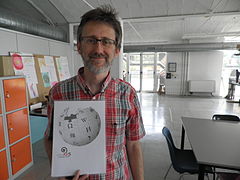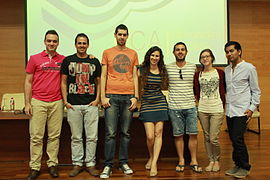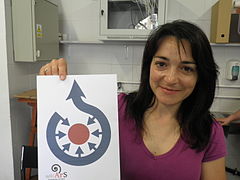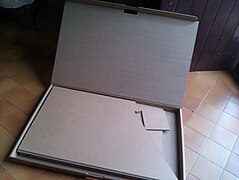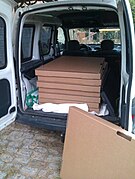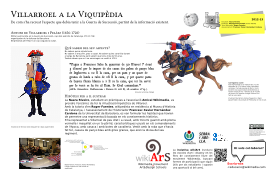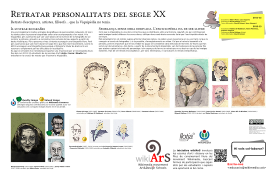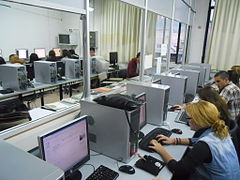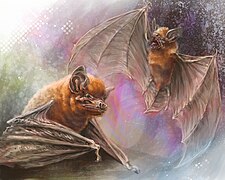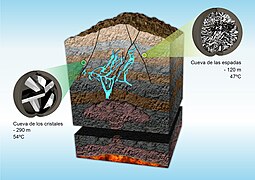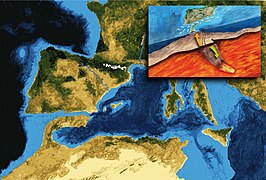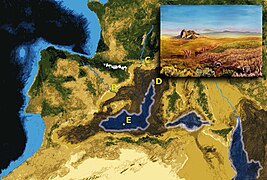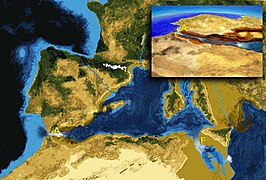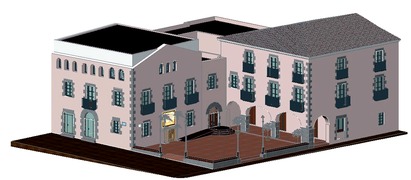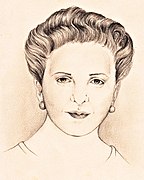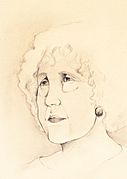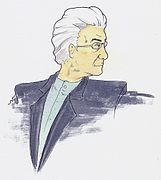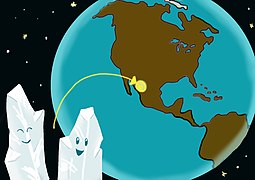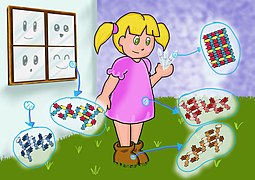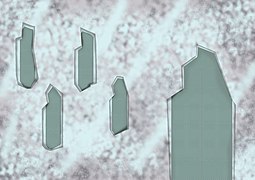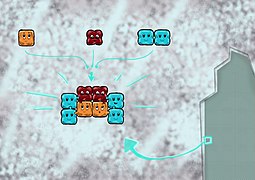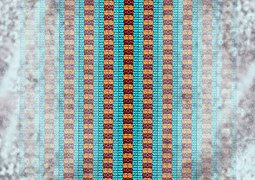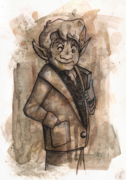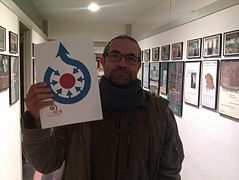Grants:IEG/Consolidate wikiArS to involve art schools/Final
![]() This project is funded by an Individual Engagement Grant
This project is funded by an Individual Engagement Grant
Welcome to this project's final report! This report shares the outcomes, impact and learnings from the Individual Engagement Grantee's 6-month project.
Part 1: The Project
[edit]Summary
[edit]In a few short sentences, give the main highlights of what happened with your project. Please include a few key findings or learnings from your project in bullet points, for readers who may not make it all the way through your report.
- Documentation pages were improved and updated; some case studies were documented.
- New resources for participants were created: an assignments creation page and an Upload Wizard Campaign adaptation.
- A three-way model for supervising and guiding students in the production of scientific and educational images was validated and documented.
- Several assignments were finished and published.
- The number of schools and wikiArS "nodes" was increased: 7 art schools and 1 high school are participating in Catalonia, and others are interested or plan to participate; the University of Cádiz is participating; and the initiative is starting in Madrid.
- The number of Wikimedian tutors (6) and subject-specific advisers (8) has increased.
- An exhibition of the results from the 2012-2013 academic year in Catalonia was produced and is ready to be shown in several places.
- We are involved in new activities such as Commons workshops, Wikidignosis and Edit-a-thons.
Methodology
[edit]In your midpoint report, you told us about the setup and background for your project. Do you have anything else to add to your methodology from the second half of your project? If so, please add it here.
- The text below will be translated into English
The IEG period overlaps the end of the 2012-2013 academic year and the first quarter of the 2013-2014 academic year. The initiative is based on a pilot project conducted during the 2011-2012 academic year and collaboration arrangements established during the 2012-2013 academic year.
During this period, we increased the number of collaboration arrangements and received feedback from various sources. This allowed us to validate, consolidate and improve our work methodologies. One of the most important methodological aspects was the validation of our three-way model for supervising and guiding students in the production of scientific and educational images. The model is summarized in the diagram below.

We made it a priority to recruit subject-specific advisers who guide students in the creation of educational and science graphics. The various assignments were defined in collaboration with these advisers and Wikipedians. The model allows anyone to become a subject-specific adviser—whether they belong to a scientific or cultural institution or not—provided that they have extensive knowledge of the topic in question and are capable of supervising students' work. The model also allows the involvement of a fourth or even fifth person, which has been necessary and possible in some cases.
Drawing on the conclusions of the pilot project (2011-2012), we kept the assignment in which students draw portraits of 20th-century figures of whom no freely usable image is available. However, the number of such assignments was limited and we stressed to students that they must not create works that are derivative.

Another important methodological aspect was assignment definition, which we implemented using an on-wiki system (wikiArS assignments). This system allowed users to generate assignments by clicking on a button that leads to a preload page with fields to fill in. Assignments are usually defined by the Wikimedian and the expert adviser, taking into account Wikipedia's needs and the adviser's topics of expertise. However, lecturers are allowed to adapt assignments to ensure that they are appropriate to the students' workload, technical skills and academic background.
We had an interesting experience with linking our assignments to WikiProjects already underway, which entailed getting Wikipedians from the existing projects involved as tutors or advisers. We did this with the Mammals (Viquiprojecte:Mamífers) and Ancient Egypt (Viquiprojecte:Antic Egipte) WikiProjects. By collaborating with these projects, we were able to detect the editors' needs more accurately and to link our image-production program to the development of encyclopedia articles.
Through our various guidance experiences, we detected obstacles and developed various proposals regarding how to improve our supervision. These proposals need to be tested and validated.
During the 2012-2013 academic year, we taught students individually or in small groups about the general purpose of the project, about the conditions and philosophy of the licenses, and about how to describe, categorize and post images on Commons. These tasks took up a considerable amount of time. In the new academic year, we have been looking for ways to optimize our efforts and make these tasks easier. One step we took was to adapt the Upload Wizard. This has really helped the students to fill in everything they need to fill in, while ignoring everything else. At schools where we felt it was necessary, at the start of the academic year we held talks and workshops about the wikiArS initiative, about free licenses, and about registering and posting images on Commons. These talks were open not only to the participating students but also to their classmates. This allowed us to raise awareness about Commons and free licenses throughout the entire group. These activities are closely aligned with the objectives of the Vocational Training and Orientation subjects and with the art students' interest in copyright-related issues.
Beyond the production of graphics, we made our first attempt to involve one of the participating schools (Llotja) in the production of written content by co-organizing a scientific illustration edit-a-thon. The relevant methodological aspect of this event was that, one month beforehand, we worked with lecturers and professionals to determine what Wikipedia needed in relation to the topic in a "Wikidiagnosis" session.
Activities
[edit]What did you do over the course of your project?
Please list all activities you’ve undertaken as part of your project, and provide a description for each activity.
My activities as an IEGrantee encompassed the various social, technical and coordination-related aspects described below.
On-wiki technical developments
[edit]
- Adapting Upload Wizard for wikiArS using Campaign: Campaign:wikiArS (working page).
- Developing mechanisms (button, preload page, templates) to create wikiArS assignments online: outreach:WikiArS/assignments (working page).
- Improving header for Commons partnership pages: commons:Template:WikiArS partnership/tab header (better for translation, "look and feel").
-
Customized Upload Wizard tutorial for wikiArS
-
Customized Upload Wizard, second step
Defining assignments and contacting advisers
[edit]
- Contacting Wikimedian communities to detect image gaps on Wikipedia or sister wikis. Posting messages on the Village Pump pages of the various projects in different languages. Contacting users participating in WikiProjects to find out what images they need; recruiting them as wikiArS collaborators. Contacting Wikipedians who might be willing to collaborate as tutors.
- Contacting and meeting with potential advisers as well as scientific and cultural institutions that might be interested in collaborating in an advisory capacity.
- Working with subject-specific advisers to define assignments that can be used by Wikipedia or sister wikis and which are also useful learning activities for art students.
- Other Wikimedians also participated in this task: Galazan, Leptictidium, Luna92 and Lluis_tgn collaborated on the definition of assignments.
Contact with schools and tutoring students
[edit]- Holding meetings and maintaining email and telephone contact with directors, heads of internships and lecturers at the art and design schools in order to present the initiative and define collaboration mechanisms, types of assignments, and timeframe.
- Dealing with the necessary documents and procedures to establish internship and collaboration agreements.
- Working with lecturers to adapt assignments to the educational context and to the specific students.
- Monitoring the students' work and the experts' guidance and, in some cases, helping to identify possible graphic solutions to make the images more comprehensible and appropriate for Wikipedia.
- Providing information, guidance and solutions to students' doubts regarding the publication of images on Commons, appropriate formats for publication, free licenses, the description and categorization of images, the insertion of images into articles, and the nomination of images for community distinctions.
-
With Llotja students and lecturer
-
Laia Sabán, edRa student
-
Carolina Gutiérrez, edRa student
-
Jaume Ferrer, edRa lecturer
-
Lorena Gutiérrez, lecturer, with UCA students on the Jerez Campus
-
Meritxell Campos, Escola d'Art de Manresa student
-
Míriam Cifre, Escola d'Art de Manresa student
-
Marc Serra, Escola d'Art del Treball student on internship at Amical Wikimedia
-
Carlota Rodríguez, Escola d'Art del Treball student on internship at Amical Wikimedia
-
Adrià Turina, Escola d'Art del Treball student on internship at Amical Wikimedia
-
Joan Lalucat, Escola d'Art del Treball student on internship at Amical Wikimedia
-
October 25th. Visit to the Museum of Montserrat with edRa and Escola d'Art del Treball students and teachers.
- Other Wikimedians also participated in these tasks: Galazan, Luna92 and Lluis_tgn tutored students; El Pantera got UCA involved in wikiArS and participated as a tutor.
Talks and workshops
[edit]- Workshops and conferences at art and design schools:
- September 27th. Badalona. Speech about wikiArS and Commons to a group of about 20 illustration students at Escola Pau Gargallo.
- October 7th. Barcelona. Talk for illustration and design students entitled "Illustrating for Wikipedia: Publishing on Wikimedia Commons" at Llotja. About 80 attendees.
- October 9th. Barcelona. Workshop for illustration students entitled "Contributing to Wikimedia Commons" at Escola d'Art del Treball. About 30 attendees.
- October 15th. Workshop for painting, ad graphics and photography students entitled "Wikimedia Commons, WikiArS and Free Licenses" at Escola d'Art de Tarragona. About 25 attendees.
- Other talks and communications:
- April 13th. Barcelona. Edit-a-thon at the Joan Miró Foundation. Brief speeches about uploading to Commons and about wikiArS (morning and afternoon).
- August 11th. Hong Kong. Wikimania, talk about wikiArS in Edu-III (Sozi presentation).
- November 20th. Barcelona. Seminar for researchers and lecturers at ICTJA (CSIC) entitled "Geoscience, Art, Wikipedia: Contributing Free Illustrations Through the WikiArS Initiative." With Daniel García-Castellanos. About 25 attendees. Organized as part of Science Week.
-
Speech about wikiArS at the 35 Years Edit-a-thon at Space 13, Joan Miró Foundation (Barcelona)
-
October 7th. Talk at Llotja
-
October 9th. Workshop at Escola d'Art del Treball
-
October 15th. Workshop at Escola d'Art de Tarragona
- Other people also participated in these tasks: the workshop in Tarragona was organized jointly with Lluis_tgn and the workshop at Escola d'Art del Treball was organized with the support of Luna92. The seminar at ICTJA was given jointly with Daniel Garcia-Castellanos. Manuel Palomo (El Pantera) and Lorena Gutíerrez (Lorgut) organized seminars about Commons and wikiArS for UCA students in Jerez. Lorena Gutíerrez presented a paper about wikiArS at the International University Innovation Conference in Madrid on 11th July.
Producing the exhibition
[edit]- Designing and building prototypes for the exhibition displays.
- Making contacts and requesting estimates from potential providers of exhibition materials and services (cutting, printing).
- Designing exhibition posters with wikiArS graphics produced during the 2011-2012 and 2012-2013 academic years.
- Ordering cartoon boards for eight exhibition displays and prints of eight posters (100 x 70 cm).
- Designing and prototyping
-
Design and first real-size prototype of wikiArS exhibition displays
-
Prototyping session and second scale model of wikiArS exhibition displays
- Exhibition displays
-
Folder for displays transport
-
Opening the folder
-
Unfolding
-
Mounting
-
Exhibition display mounted
-
You can carry all in a single car
- Exhibition posters
-
Poster about graphic creators in Commons
-
Poster explaining wikiArS initiative
-
Poster about graphics and movie explaining Messinian Salinity Crisis
-
Poster about infographics and illustrations explaining giant crystals in Naica
-
Poster about the creation of animals scientific illustrations
-
Poster about historical reconstruction of XVIII Century personality appearance
-
Poster about the creation of XX Century personalities portraits
-
Poster about the creation of XX Century politicians portraits
- Enric Gili, an expert in setting up exhibitions, collaborated with me on the design and prototypes of the exhibition displays.
Organization of the Edit-a-thon at Llotja
[edit]The organization of the Scientific Illustration Edit-a-thon at Llotja included the following tasks:
- Contacting and holding meetings with the organizing groups: Amical Wikimedia, Escola d'Art Llotja, the Catalan Association for Science Communication (ACCC) and the Barcelona Museum of Natural Sciences.
- Contacting professional scientific illustrators with the goal of recruiting them as collaborators.
- Preparing the Scientific Illustration WikiProject on the Catalan-language Wikipedia and the following pages: Wikidiagnosis, Edit-a-thon, To-Do and Bibliography.
- Registering the Edit-a-thon as part of Science Week at the website of the Catalan Foundation for Research.
- Organizing and leading the Wikidiagnosis session on October 23rd at Llotja to evaluate what content Wikipedia has on the topic of scientific illustration and what is missing. Attended by 12 people (professional illustrators, art lecturers, science communicators).
- Working with the Documentation Center of the Barcelona Museum of Natural Sciences to prepare the reference bibliography.
- Contacting Wikipedians to ask them to review our To-Do list in order to identify existing articles in other languages, improve article titles and conduct a pre-assessment of admissibility.
- Organizing the eight-hour Edit-a-thon on November 21st at Llotja with more than 30 participants.
- Post-Edit-a-thon tasks such as organizing the results, congratulating the participants and updating the To-Do list.
- Preparing various materials and announcements regarding the different stages of the process for dissemination via the media and social networks.
The Edit-a-thon was part of Science Week. As a parallel activity, an exhibition of Jordi Sabaté Pi drawings was held at Llotja to commemorate the 10th anniversary of the death of Snowflake at the Barcelona Zoo.
-
Wikidiagnosis, October 23rd
-
Wikidiagnosis, October 23rd
-
Edit-a-thon, November 21st
-
Edit-a-thon, November 21st
-
Edit-a-thon, November 21st
-
Edit-a-thon, November 21st
-
Edit-a-thon, November 21st
-
Edit-a-thon, November 21st
-
Edit-a-thon, November 21st
-
Edit-a-thon, November 21st
-
Edit-a-thon, November 21st
-
Edit-a-thon, November 21st
- A significant portion of the organizational work was done in collaboration with people from the collaborating institutions, such as communications officers from the Barcelona Museum of Natural Sciences, the Catalan Association for Science Communication (ACCC) and Amical Wikipedia; the staff of the Documentation Center of the Barcelona Museum of Natural Sciences; and the teaching staff at Llotja.
Writings, co-writings and reports
[edit]My own writings and reports, co-writings with others, and writings from others about wikiArS.
- Academic paper:
- Gutiérrez Madroñal, Lorena; Gómez Fontanills, David; Collado Machuca, José Carlos; Palomo Duarte, Manuel (2013) Desarrollo de materiales multimedia libres de carácter enciclopédico: Del aula a Wikimedia Commons (in Spanish)Jornadas Internacionales de Innovación Universitaria . See also the Prezi from the July 11th presentation by Lorena Gutíerrez
- Reports:
- Wikimedia Education Newsletter:
- This Month in Education – Volume 2, Issue 6, June 2013 > Growing contributions from wikiArS initiative
- This Month in Education – Volume 1, Issue 5, December 2012 > wikiArS initiative in Catalonia
- Wikimedia GLAMwiki Newsletter:
- This Month in GLAM – Volume III, Issue V, May 2013 > Students create graphics under expert advice
- Wikimedia Education Newsletter:
- Case studies:
- wikiArS case studies page (7 cases reported to date)
- Explaining Naica infographically (David Gómez 2013, in Catalan and in Spanish)
- Outreach:
- Daniel García-Castellanos "Geociencia, Wikipedia y Arte. La experiencia wikiArS" (Geoscience, Wikipedia and Art: The WikiArS Experience). Blog "Retos terrícolas" 31-10-2013 and Wikipedia, Ciencia y Arte. Generando ilustraciones científicas a través de wikiArS. Blog of Wikimedia España 1-11-2013 (in Spanish)
- David Gómez S'acosta la Viquimarató sobre il·lustració científica. Blog of Amical Wikimedia. 14-11-2013 (in Catalan)
- David Gómez Viquimarató sobre il·lustració científica. Blog of the Barcelona Museum of Natural Sciences. 28-11-2013 (in Catalan)
- L'ACCC coorganitza una viquimarató d'il·lustració científica. Blog of the Catalan Association for Science Communication (ACCC)] 13-11-2013 (in Catalan)
- Viquimarató a Llotja sobre il·lustració científica. Llotja's illustration blog. 14-11-2013 (in Catalan)
Outcomes and impact
[edit]What are the results of your project?
Please discuss anything you have created or changed (organized, built, grown, etc) as a result of your project.
 On Commons &
On Commons & 

 on wikis
on wikis
[edit]Images
[edit]- Infographics, diagrams, scientific and educational illustrations, historical and architectonic recreations, etc., for Wikipedia and/or Wikispecies...
-
Recreation of extinct Chapalmalania based on current knowledge

-
Recreation of extinct Cryptoprocta spelea based on current knowledge
-
Scientific illustration of Miniopterus manavi (from Madagascar)
-
Recreation of extinct Thadeosaurus based on current knowledge
-
Naica Mine caves

-
Naica Mine mineralization process

-
Little nucleation of crystals.
-
Intermediate nucleation of crystals
-
High nucleation of crystals
-
Recreation drawning of Antoni de Villarroel based on documentation about the purchase of a uniform
-
Recreation drawning of Antoni de Villarroel on horseback
-
3D representation of "Can Juncosa" building in Arenys de Mar.
-
3D representation of the Arenys de Mar City Hall
-
3D representation of St. Mary's Church in Arenys de Mar
- Portraits of 20th-century figures, including writers, politicians and philosophers...
-
Torrente Ballester
-
Miguel Delives
-
Juan Carlos Onetti
-
Rosa Chacel
-
Elena Quiroga
-
Concha Espina
-
Josep Laporte i Salas
-
Jordi Planasdemunt Gubert
-
Ramon Trias Fargas
-
Simone de Beauvoir
-
Ayn Rand
-
François Chatelet
-
Jaques Lacan
- Educational illustrations for Wikijunior in Wikibooks...
-
Location of the Naica Mine in the world
-
Location and difference between the crystal caves of the Naica Mine
-
Crystals in the Cave of Swords
-
Crystals in the Cave of Crystals
-
Size difference between the caves
-
Everything is made of atoms and molecules
-
How crystals are formed
-
Calcium sulphate and water form gypsum crystals
-
The molecules are stacked
-
Speed of crystallization in the Cave of Swords results in smaller crystals
-
Temperature differences determine the density and velocity
-
This is why there are giant crystals in Naica
Videos
[edit]- Videos and 3D animations of geology, physics phenomena, construction, magic tricks, health...
-
Messinian crisis animated sequence
-
Rutherford atom model (animated)
-
Boiling water process
-
Construction of a single-footing foundation
-
Telekinesis magic trick
-
Correct position to take blood pressure Media of the day 19-6-2013
-
Proprioceptive work with Freeman table
In context
[edit]Use of wikiArS contributions in Wikimedia projects (GLAMourous link for updated information)
| Use of wikiArS contributions in Wikipedias (only articles namespace) | |||||
|---|---|---|---|---|---|
| Wikipedia | Files used | Pages using files | Wikipedia | Files used | Pages using files |
| ca.wikipedia.org | 48 | 49 | pt.wikipedia.org | 5 | 5 |
| es.wikipedia.org | 42 | 45 | de.wikipedia.org | 4 | 4 |
| en.wikipedia.org | 27 | 24 | hu.wikipedia.org | 4 | 4 |
| fr.wikipedia.org | 14 | 16 | pl.wikipedia.org | 5 | 4 |
| it.wikipedia.org | 7 | 9 | fi.wikipedia.org | 3 | 3 |
| nl.wikipedia.org | 7 | 7 | sk.wikipedia.org | 2 | 2 |
| ru.wikipedia.org | 6 | 7 | sv.wikipedia.org | 2 | 2 |
| eu.wikipedia.org | 6 | 6 | uk.wikipedia.org | 2 | 2 |
| gl.wikipedia.org | 6 | 6 | Only 1 used in an, ast, bn, da, el, eo, he, io, it, ja, ml, no, qu, ro, th and zh | ||
If Wikipedia in your language doesn't use them or only uses a few, you can change this! | |||||
|
| ||||||||||||||||||||||||
Participants
[edit]Click "expand" to read the lists of participants.
| List of students | |||||
|---|---|---|---|---|---|
| Name | Academic year | School | Assignment | Status | Notes |
| Luís Segovia | 2011-12 | Llotja | Portraits of 20th-century illustrators | Lecturer: Alicia Gallego. Wikimedian tutors: Dvdgmz, Pallares | |
| Albert Pons | 2011-12 | Llotja | Portraits of 20th-century Catalan writers | Lecturer: Alicia Gallego. Wikimedian tutors: Dvdgmz, Pallares | |
| Oriol Tuca | 2011-12 | Llotja | Scenes of flows | Lecturer: Alicia Gallego. Wikimedian tutors: Dvdgmz, Pallares | |
| Jessica León | 2011-12 | Llotja | Tolkien fiction characters | Lecturer: Alicia Gallego. Wikimedian tutors: Dvdgmz, Pallares | |
| Pau Bahí | 2011-12 | Llotja | Messinian salinity crisis | Lecturer: Alicia Gallego. Wikimedian tutors: Dvdgmz, Pallares. Adviser: Daniel García-Casatellanos | |
| Bàrbara Domenech | 2011-12 | Serra i Abella | Portraits of XX century politicians | Lecturer: Àngels Franch. Wikimedian tutor: Dvdgmz | |
| Núria Martínez | 2012-13 | Llotja | Portraits of 20th-century Spanish writers | Lecturer: Alicia Gallego. Wikimedian tutor: Dvdgmz | |
| Diana Francitorra | 2012-13 | Llotja | Portraits of 20th-century politicians | Lecturer: Alicia Gallego. Wikimedian tutor: Dvdgmz | |
| Antonio Climent | 2012-13 | Llotja | Portraits of 20th-century philosophers | Lecturer: Alicia Gallego. Wikimedian tutor: Dvdgmz | |
| Manuel Redondo | 2012-13 | Llotja | Portraits of 20th-century philosophers | Lecturer: Alicia Gallego. Wikimedian tutor: Dvdgmz | |
| Daniel Burch Caballé | 2012-13 | Llotja | Extinct mammal Cryptoprocta spelea | Lecturer: Luis Casado. Wikimedian tutor: Dvdgmz. Adviser: Alistair Ian Spearing | |
| Edgar Sanchez | 2012-13 | Llotja | Rare bat Miniopterus manavi | Lecturer: Luis Casado. Wikimedian tutor: Dvdgmz. Adviser: Alistair Ian Spearing | |
| David Fernández | 2012-13 | Llotja | Extinct mammal Chapalmalania | Lecturer: Luis Casado. Wikimedian tutor: Dvdgmz. Adviser: Alistair Ian Spearing | |
| Miquel Borrull | 2012-13 | Llotja | Extinct Thadeosaurus | Lecturer: Luis Casado. Wikimedian tutor: Dvdgmz. Adviser: Alistair Ian Spearing | |
| Naara Riveiro | 2012-13 | Serra i Abella | Historical recreation of A.Villarroel appearance | Lecturer: Mariapaola Piscitelli. Wikimedian tutor: Galazan. Adviser: Francesc Xavier Hernández Cardona. | |
| Albert Vila | 2012-13 | edRa | Naica Mine | Lecturer: Jaume Ferrer. Wikimedian tutor: Dvdgmz. Advisers: Àngels Canals. | |
| Andreu Modenes | 2012-13 | edRa | Naica Mine | Lecturer: Jaume Ferrer. Wikimedian tutor: Dvdgmz. Advisers: Àngels Canals. | |
| Carolina Gutíerrez | 2012-13 | edRa | Naica Mine | Lecturer: Jaume Ferrer. Wikimedian tutor: Dvdgmz. Advisers: Àngels Canals. | |
| Laia Sabán | 2012-13 | edRa | Naica Mine | Lecturer: Jaume Ferrer. Wikimedian tutor: Dvdgmz. Advisers: Àngels Canals. | |
| Manuel Jesús Arteaga Rico | 2012-13 | UCA | Right position for taking blood pressure | Lecturer: Lorena Gutiérrez. Wikimedian tutor: El pantera. Adviser: Pablo Geara Joyed and Abraham Gil Sánchez | |
| Cristobal Sánchez Ruiz | 2012-13 | UCA | Boiling | Lecturer: Lorena Gutiérrez. Wikimedian tutor: El pantera. Adviser:José Carlos Sánchez Muñoz | |
| Carlos Calvo Luna | 2012-13 | Llotja | Foundation | Lecturer: Lorena Gutiérrez. Wikimedian tutor: El pantera. Adviser: Miguel Ángel Sánchez Muñoz | |
| Miguel Angel Rodríguez Vázquez | 2012-13 | Llotja | Lower limb proprioceptive work | Lecturer: Lorena Gutiérrez. Wikimedian tutor: El pantera. Adviser: Pablo Geara Joyed and Abraham Gil Sánchez | |
| Daniel Torres Sánchez | 2012-13 | Llotja | Telekinesis | Lecturer: Lorena Gutiérrez. Wikimedian tutor: El pantera | |
| David Marín Sánchez | 2012-13 | Llotja | Rutherford model | Lecturer: Lorena Gutiérrez. Wikimedian tutor: El pantera. Adviser:José Carlos Sánchez Muñoz | |
| Federica Brigida | 2012-13 | Llotja | xxxxxxx | Lecturer: Alicia Gallego. Wikimedian tutor: Dvdgmz. Adviser: Marina Bolado Penagos and Daniel García-Castellanos | |
| Meritxell Campos | 2012-13 | Manresa School of Art | formation of the Montserrat massif | Lecturer: Roser Comas. Wikimedian tutor: Dvdgmz | |
| Míriam Cifre | 2012-13 | Manresa School of Art | Cardona diapir formation | Lecturer: Roser Comas. Wikimedian tutor: Dvdgmz | |
| Joan Lalucat | 2013-14 | Art del Treball | Recreation of Amarna city | Lecturer: Jordi Catafal. Wikimedian tutor: Dvdgmz and Luna92. Adviser: Ramon Serra | |
| Adrià Turina | 2013-14 | Art del Treball | Recreation of Amarna city | Lecturer: Jordi Catafal. Wikimedian tutor: Dvdgmz and Luna92. Adviser: Ramon Serra | |
| Annabel Tapiolas | 2013-14 | edRa | Timetable of Egyptian sarcophagus | Lecturer: Jaume Ferrer. Wikimedian tutor: Dvdgmz and Luna92. Adviser: Ramon Serra | |
| Javier Cabanillas | 2013-14 | edRa | Timetable of Egyptian sarcophagus | Lecturer: Jaume Ferrer. Wikimedian tutor: Dvdgmz and Luna92. Adviser: Ramon Serra | |
| Adrià Turina | 2013-14 | Art del Treball | Recreation of Amarna city | Lecturer: Jordi Catafal. Wikimedian tutor: Dvdgmz and Luna92. Adviser: Ramon Serra | |
| Marc Serra Llop | 2013-14 | Art del Treball | Scientific illustration of mushrooms, Lactarius | Lecturer: Jordi Catafal. Wikimedian tutor: Dvdgmz. Adviser: Josep Cuello | |
| Carlota Rodríguez | 2013-14 | Art del Treball | Scientific illustration of mushrooms, Lactarius | Lecturer: Jordi Catafal. Wikimedian tutor: Dvdgmz. Adviser: Josep Cuello | |
| Yolanda Oreiro | 2013-14 | Pau Gargallo (Badalona) | Educational illustration about submarine canyons | Lecturer: Jordi Badal. Wikimedian tutor: Dvdgmz. Adviser: David Amblàs | |
| Cristina Toro | 2013-14 | Tarragona School of Art | Hypothetical illustration of the statue of Augustus in Tarraco | Lecturer: Àngel Sauret. Wikimedian tutor: Lluis_tgn. Advisers: Francesc Tarrats Bou, Pilar Sada, Montserrat Perramon, Josep Anton Remolà, Joaquin Ruiz de Arbulo Bayona | |
| Meritxell Guasch Artacho | 2013-14 | Tarragona School of Art | Recreation of "Els Munts" roman villa latrines scene. | Lecturer: Àngel Sauret. Wikimedian tutor: Lluis_tgn. Advisers: Francesc Tarrats Bou, Pilar Sada, Montserrat Perramon, Josep Anton Remolà | |
| Dylan Calaf Latham | 2013-14 | Tarragona School of Art | Recreation of "Els Munts" roman villa warm bath scene. | Lecturer: Àngel Sauret. Wikimedian tutor: Lluis_tgn. Advisers: Francesc Tarrats Bou, Pilar Sada, Montserrat Perramon, Josep Anton Remolà | |
| Guillem Duran Masip | 2013-14 | Tarragona School of Art | Illustration of three hunting scenes in the Late Roman Period | Lecturer: Àngel Sauret. Wikimedian tutor: Lluis_tgn. Advisers: Francesc Tarrats Bou, Pilar Sada, Montserrat Perramon, Josep Anton Remolà | |
| List of art and design lecturers involved | ||||
|---|---|---|---|---|
| Name | Since | School | Location | Notes |
| Alicia Gallego | 2011 | Llotja | Barcelona | Illustration course coordinator |
| Luis Casado | 2011 | Llotja | Barcelona | lecturer of cientific illustration |
| Àngels Blanch | 2011 | Serra i Abella | L'Hospitalet | internships responsible |
| Jaume Ferrer | 2012 | edRa | Rubí | lecturer of design and multimedia |
| Mariapaola Piscitelli | 2013 | Serra i Abella | L'Hospitalet | lecturer of illustration |
| Lorena Gutiérrez | 2013 | UCA (Bachelor's Degree in Advertising and Public Relations) | Jerez | lecturer of Multimedia and Animation Tools |
| Roser Comas | 2013 | Manresa School of Art | Manresa | internships responsible |
| Jordi Catafal | 2013 | Art del Treball | Barcelona | internships responsible |
| Àngel Sauret | 2013 | Tarragona School of Art | Tarragona | lecturer of illustration |
| Jordi Badal | 2013 | Pau Gargallo | Badalona | internships responsible |
| List of subject-specific advisers | ||
|---|---|---|
| Name | Since | Notes |
| Daniel García-Castellanos | 2011 | Geophysicist, Researcher at Jaume Almera Earth Science Institute (CSIC) |
| Alistair Ian Spearing Ortiz | 2011 | Science translator, wikimedian, active in Wikiproject:Mammals |
| Francesc Xavier Hernández Cardona | 2012 | Historian, Professor at University of Barcelona, Didactics of History Group |
| Àngels Canals | 2012 | Geologist, Professor at University of Barcelona, Faculty of Geology |
| Fidel Grandia | 2013 | Geologist from Amphos21 and Polytechnic University of Catalonia |
| David Amblàs | 2013 | Geologist, Professor at University of Barcelona, Faculty of Geology |
| Marina Bolado Penagos | 2013 | Faculty of Marine and Environmental Sciences, of the University of Cádiz |
| Pablo Geara Joyed | 2013 | Faculty of medicine, University of Seville |
| Abraham Gil Sánchez | 2013 | School of Nursery and Physiotherapy, University of Cádiz |
| José Carlos Sánchez Muñoz | 2013 | School of Engineering of Seville. |
| Miguel Ángel Sánchez Muñoz | 2013 | Escuela Técnica Superior de Arquitectura, University of Seville |
| Ramon Serra Massansalvador | 2013 | History of Art and Illustration lecturer, Art del Treball School |
| Josep Cuello | 2013 | Biologist, mycologist |
| Francesc Tarrats Bou | 2013 | Director of National Archaeological Museum of Tarragona (MNAT) |
| Pilar Sada | 2013 | Curator at National Archaeological Museum of Tarragona (MNAT) |
| Montserrat Perramon | 2013 | Curator at National Archaeological Museum of Tarragona (MNAT) |
| Josep Anton Remolà | 2013 | Curator at National Archaeological Museum of Tarragona (MNAT) |
| Joaquin Ruiz de Arbulo Bayona | 2013 | Professor of Archaeology at Rovira i Virgili University in Tarragona |
| List of wikimedian tutors | ||
|---|---|---|
| User/Name | Since | Area |
| David Gómez | 2011 | Catalonia, Barcelona area preferably |
| Pallares | 2011-12 | Barcelona area |
| Roger Fuentes | 2013 | Catalonia, Barcelona area preferably |
| Manuel Palomo | 2013 | Andalusia, Cadiz & Jerez |
| Lluis_tgn | 2013 | Tarragona area |
| Judit Luna | 2013 | Barcelona area |
| Rubén Ojeda | 2013 | Madrid |
-
David Amblàs, David Gómez and Yolanda Oreiro; Faculty of Geology UB
-
N.Riveiro, F.X.Hernández and Roger Fuentes; Faculty of Pedagogy UB
-
Laia Sabán, edRa student
-
Carolina Gutiérrez, edRa student
-
MNAT director and curators
-
User Lluis_tgn at MNAT
-
Cristina Toro, EA-Tarragona student
-
Guillem Duran, EA-Tarragona student
-
Meritxell Guasch, EA-Tarragona student
-
Dylan Calaf, EA-Tarragona student
-
Angel Sauret, EA-Tarragona lecturer
-
Luis Casado, David Gómez and Meritxell Campos at Llotja
Progress towards stated goals and targets
[edit]Please use the provided table to:
- List each of your original goals/targets (measures of success) from your project plan.
- Next to each goal/target, list the actual outcome that was achieved.
- Explain how your outcome compares with the original goal. Did you reach your planned targets? Why or why not?
| Planned measure of success (include numeric target, if applicable) |
Actual result | Explanation |
| To bring the project to a more consolidated stage | Achieved.
|
The IEG has been an opportunity for me to dedicate extra time to consolidating the project and gaining a more comprehensive perspective on wikiArS. |
Methodology and documentation
|
|
We have achieved our goals related to documenting our methodology. New experiences can be added to the spaces that we have created for this purpose. |
To get schools involved:
|
|
At Llotja, the school where we piloted this experience in 2011-2012, the number of participating lecturers and students has increased. A further 6 schools have also joined the initiative. We have been in contact with other schools that have expressed interest, but we have not yet found a way for them to participate. As a result of our efforts to publicize the initiative, we made contact with a high school that ended up contributing 3D graphic representations of historic buildings that they had produced with free licenses in recent years. The UOC has decided to offer the opportunity to participate in the initiative as part of the final project for students in the Multimedia Degree next semester. Most of the students who have participated so far are specializing in illustration. We are working to get more design students involved, both at the participating schools and at the other schools we have been in contact with. |
|
|
We have uploaded more images than we expected. However, we are primarily interested in the number of assignments completed, because each assignment covers a Wikipedia need, whether for a single image or for a set of images. The IEG period overlapped two different academic years, and we do not yet have final results for the current year. However, various assignments are already underway. The images are valuable for at least three reasons: 1) they fill an identified gap, 2) they are made by students at a quasi-professional level, and 3) they are produced under the supervision of good advisers. We try to confirm the quality of the images with the community in two ways: by announcing new images on the Village Pump pages (where they receive feedback and, in some cases, corrections), and by nominating images for distinctions on Commons and on the various Wikipedias. The criteria for Quality Image and Featured Picture on Commons are very much oriented towards the assessment of photographs. Nominating illustrations for these distinctions is a way to open the door for other types of graphics. When an image is not promoted, the comments associated with votes against it help us to improve the assignments and the guidance we provide to students. |
| To create between 2 and 5 types of promotional materials |
|
We have met our objectives, although some of these materials still need to be translated to other languages. We can continue to work on this as needs dictate. |
|
|
The production of the exhibition was delayed; therefore, it has been produced but not presented. This happened for various reasons: After the exhibition displays were designed and a prototype was made by hand, I was unable to find a supplier to cut the cardboard at a reasonable price (see budgets) until one of the cardboard suppliers I had been in contact with told me that they had purchased a cutting machine. Also, I had planned to design the posters in July using images produced during the 2012-2013 academic year, but some of the students had not yet finished their assignments. Then, in September and October of this year, I was very busy organizing the Edit-a-thon at Llotja and had little time to work on the design. Nevertheless, initial versions of 2 posters were displayed as part of Science Week at ICTJA and at the Faculty of Geology of the University of Barcelona (these posters are now on display at edRa). Additionally, 4 wikiArS illustrations were included in the exhibition "Sabaté Pi and Scientific Illustration" at Llotja. Finally, posters highlighting the wikiArS results were displayed at the Edit-a-thons at the Catalan History Museum and at Llotja. We have been in contact with the Catalan Government's Library Service about presenting the exhibition throughout their network of libraries. |
Advisors and tutors
|
|
During the 2012-2013 and 2013-2014 academic years, we have gradually added new people as advisers in different areas of knowledge. I have also been in contact with a few more people, as well as institutions that may be interested in collaborating. In some cases, these people and institutions have not yet made a decision; in other cases, we are now in the process of preparing possible assignments.
Daniel García-Castellanos's efforts to promote the wikiArS initiative at his research Institute, in the Faculty of Biology and on his blog have helped us to find new advisers and to spread the word about our experiences in the geoscience field. The involvement of the director and curators of the National Archeological Museum of Tarragona (MNAT)—with Pilar Sada as the main contact person—is a very good example of how a GLAM institution can get involved. Wikipedians involved in specific WikiProjects have also made a considerable contribution in advisory roles: Alistair Spearing as a subject-specific adviser and Galazan and Luna92 as tutors. |
|
|
The participation of UCA was our first experience outside of Catalonia. It took place in a different academic context (university-level subject) and involved a different type of graphic (animation). The Madrid node is off to a good start. The IEG has helped us to consolidate and document the initiative, thereby making it much easier to replicate elsewhere. I discussed replication of the project in my talk at Wikimania. I have also personally discussed this with various individuals in different countries, and they have shown interest. In the case of a few other contacts, it remains to be seen whether they are interested in moving forward. The initiative is internationalizable, but it needs to grow sustainably, starting with a person or group of people who wish to launch it in their area. |
Qualitative feedback and coverage
|
|
The lecturers have described the initiative as very positive and the participating schools will be staying on next year. None of the students who have participated in previous years have continued to contribute. This may be because they were in the last year of their studies and have been focused on finding a job since graduating. We remain in contact with them and hope they will participate again a few years from now. In any event, the students tend to respond very well when the community requests particular improvements or adjustments to their contributions. Some of the UCA students have agreed to help their classmates who will be participating next semester. We have received feedback after posting our results on the pages of the Wikimedia project communities. Members of these communities have provided opinions and suggestions—which we have tried to take into account—and have also congratulated us, in some cases. The initiative has had a considerable impact on social media. The Edit-a-thon, in particular, led to many recommendations and retweets, as well as the attention of blogs and newsletters. The participation of edRa was covered by the local media. |
Strategic impact
[edit]Please reflect on Wikimedia’s strategic priorities. We've provided 3 options below for the strategic priorities that IEG projects are mostly likely to impact. Select one or more strategic priorities that you feel your project has had impact on. Answer the question related to the priority you've selected by sharing any measures of success you have that point to this impact.
Option A: How did you increase participation in one or more Wikimedia projects?
Option B: How did you improve quality on one or more Wikimedia projects?
Option C: How did you increase the reach (readership) of one or more Wikimedia projects?
- How did you increase participation in one or more Wikimedia projects?
- The wikiArS initiative is adapted to a specific type of educational institution: art and design schools (or other schools and courses that provide art training). We provide examples and methodological proposals to facilitate the schools' involvement, as well as identification and shared spaces in order to increase visibility.
- The experiences of our educational program aimed to make writing about particular topics on Wikipedia educationally useful to students from other disciplines, and we have done this with the art and design schools as well. However, we have also gotten art students to participate through one of their primary activities: the production of graphics.
- WikiArS has also offered subject-specific experts the chance to spread their knowledge in a way other than by writing articles: by acting as advisers to the students producing the images.
- The images produced by the wikiArS initiative are valid for any language and can therefore enrich all Wikipedias. We have also contributed images for Wikijunior (Wikibooks) and Wikispecies.
- How did you improve quality on one or more Wikimedia projects?
- The illustration of articles helps Wikipedia to improve as an encyclopedia. Images facilitate comprehension of the content, and they sometimes convey information that a photograph cannot. This is the area in which art and design schools can make a valuable contributions.
- Because the assignments are defined taking into account the existing image gaps on Wikipedia (and sister wikis), we are contributing needed images.
- The three-way supervision model (Wikimedians, art lecturers and subject-specific experts) has allowed us to guide students in the production of high-quality graphics and to minimize errors. The assessments of the pilot experience and the Wikipedians’ feedback has also been useful to us.
- Activities such as the Scientific Illustration Edit-a-thon have also helped to improve written content.
- How did you increase the reach (readership) of one or more Wikimedia projects?
- Through wikiArS, we raise awareness about Wikimedia Commons among students at art and design schools. We explain what it is, how publishing works, how to create a personal page, how to describe or categorize images, and how free licenses work. They learn this through the contribution of images (therefore, as authors of images). In our workshops, we explained that they can use public-domain images or create derivative works based on freely usable images provided that they respect the terms of the license. (As a result, they also become familiar with Commons as a repository where they can search for images.)
Additional impact
[edit]Did your project have any other kinds of impact you had not anticipated when you planned your goals and targets?
Lessons learned
[edit]The best thing about trying something new is that you learn from it. We want to follow in your footsteps and learn along with you, and we want to know that you took enough risks in your project to have learned something really interesting! Think about what recommendations you have for others who may follow in your footsteps, and use the below sections to describe what worked and what didn’t.
What worked well
[edit]What was successful? What would you recommend doing again? Please list these as short bullet points.
- The three-way supervision model successfully produced good, error-free graphics. If you wish to launch a wikiArS experience, take this into account. If possible, it is a good idea to get input from even more people, as we did in the case of the stories about the Naica Mine. In addition to a geologist, we also got input from an educator and a group of schoolchildren. It may be the case that the Wikimedia tutor is also the subject-specific advisor or the art lecturer. In other words, multiple roles can be played by a single person if he or she has the necessary skills.
- In the definition of the assignments, we found it very useful to ask what the (active) WikiProjects need. You can ask about this at the Village Pump or look around for yourself, but the people working on specific a WikiProject tend to have a clearer idea of the existing image gaps. It is also possible to approach WikiProject participants about becoming tutors or advisers. In general, it is good to seek out existing projects or activities for which wikiArS can provide support.
- It is a good idea to negotiate the assignments with the various stakeholders, in particular the subject-specific advisers. Ask the advisers what they can and would like to provide advice about. Ask them to look at the image gaps you have detected. Ask about the general condition of Wikipedia articles on "their" subject. Once the assignment has been defined, you should be open to renegotiating it with the lecturer, who is familiar with the students' workload and abilities. Adjusting assignments by mutual agreement with advisers and lecturers can help to guarantee successful work.
- Advising conditions. To the extent possible, it is a good idea to let each adviser decide where the advising should take place: Will they go to the art school, or should the students go to their office? Advisers should also decide how advising will work (entirely in-person, partially online or entirely online?), what channels should be used (e-mail, on-wiki, etc.?), and how many students they can take on. Adapting collaboration arrangements to the adviser's availability and work habits can help make things run smoothly.
- Expertise + community = quality improvement. Announce the publication of images to the Wikimedian community through the Village Pump pages and other means. Someone might identify aspects of an image that need to be corrected; if so, ask the student to take care of it. Although the images are produced under expert supervision, public scrutiny can detect things that have been overlooked.
- An assignment can be for a single student or for a team, and a group of assignments can be related to each other. A complex assignment can be divided into parts or done by a team. At some schools, students are used to working in pairs on a single assignment; ask the lecturers if this is the case. Even if you use individual assignments, the fact that the students are working on the same topic may encourage them to work together during the documentation stage.
- Reference images. When you hold meetings at schools with students and advisers, it is useful to bring reference images (either on paper, on a computer screen or on a mobile device) so that you can discuss them. These images could be on the same topic or different topics. In any case, they should be good examples of graphic solutions and representation models. Some images on Commons may be appropriate for this purpose, but you can also use images from visual encyclopedias, textbooks and other scientific dissemination materials.
- Public activities. Organizing public activities (panel discussions, exhibitions, edit-a-thons) can strengthen collaboration with the schools, make the initiative more widely known in society, and lead to contacts with design and illustration professionals and cultural institutions. This was the case with the Edit-a-thon held at Llotja.
- Project with a GLAM. This is not always easy to do, but if cultural institutions wish to get involved it is possible to organize projects of interest to them. This was the case with the National Archeological Museum of Tarragona (MNAT) and the Escola d'Art de Tarragona. Quite a few curators from the museum participated as advisers. We defined assignments related to the figure of Augustus (to mark the 2,000th anniversary of his death) in the framework of the museum’s research and dissemination projects. In addition to receiving information and documentation, the students visited the museum and several archaeological sites in the city that were related to the assignment.
What didn’t work
[edit]What would you not do again or recommend that others do differently in the future? Please list these as short bullet points.
- Not every door you knock on will open. Some schools may seem interested, but then participation arrangements are never made. The schools sometimes need to take their time. Institutions such as museums are also sometimes slow at deciding to collaborate or specifying how they want to be involved. Be patient and knock on other doors in the meantime.
- Don't expect that everyone will do their job independently without follow-up. Monitor the process. If you run into an obstacle or someone stops responding, mediate between the various parties. Help find additional information if necessary. Send out reminders to make sure that the agreed timeframe is followed.
- Don't expect that the community will respond to all of your messages or that they will do so promptly. Sometimes the Wikimedian community surprises you by quickly coming to your assistance. And sometimes they do the opposite: you don't get any reply to your requests (to identify images that are lacking, to translate texts, to participate as an adviser, to create a template, to provide other technical assistance, etc.). Expect either reaction and seek out alternatives. Be ready to reformulate or set aside your idea and explore more promising channels.
Other recommendations
[edit]If you have additional recommendations or reflections that don’t fit into the above sections, please list them here.
- Win-win-win. By creating images for wikiArS, students perform an activity that allows them to learn and meet people while collaborating on a project—Wikipedia—that benefits all of society. Advisers can also benefit from the creation of images: as long as they respect the terms of the license, they can use the images in their publications, talks or institutions.
- Involving WiRs and insiders. Wikipedians-in-residence (WiRs) at GLAM institutions can use wikiArS to support their work by creating images that are useful both to the institution and to Wikipedia. WiRs can also act as liaisons by approaching institution staff members about participating as advisers or about organizing events that publicize the images created. WiRs working in disciplines related to those of the project can also act as wikiArS tutors (as in the case of Galazan, a WiR at the Catalan History Museum; read). In general, try to get insiders involved. Seek out receptive individuals at institutions or in professional groups who may wish to participate and/or tell their colleagues about the initiative. In our case, the involvement of Daniel García-Castellanos in his double role as a Wikimedian and a geoscience researcher was essential to getting other researchers and lecturers involved.
- Be careful with portrait assignments. Many portraits are needed to accompany biographies on Wikipedia, especially for 20th-century figures of whom no freely usable photograph is available. But there are a few points that you should keep in mind: 1) the student must be skilled enough in portraiture to make an image that resembles the person; 2) the student will not be able to see the subject in person and must instead rely on photos and video recordings; 3) the portrait must not be considered a derivative work based on existing protected images; and 4) the portrait must be done in an informative style that is appropriate for an encyclopedia, not as a caricature or an interpretive portrait. This entails a huge challenge for the students, because these conditions are somewhat contradictory. The lecturer must understand this very clearly and work with you to get this point across to the students. Because of these concerns, some portraits have been criticized and even removed from Commons. Students who were well advised and had the necessary skills were able to make good portraits (See).
- Nomination of images. Nominating images for community distinctions on Commons (VI, QI, FP) or with Wikipedian communities is a way to reward the students' efforts and get feedback about the results. If images are criticized, make sure the necessary corrections are made and take it into account for future assignments. Bear in mind, however, that most nominated images are photographs and that the technical and formal criteria are highly oriented towards this format. Nominating and assessing non-photographic images—particularly images created expressly for this purpose (as opposed to old images in the public domain)—can help to create and expand a community as well as shared criteria for illustrations and design work.
- WikiArS assignments. There is a page where assignments can be defined on-wiki. The page includes guidelines for creating assignments. Make sure you use this page.
- WikiArS Upload Wizard. There is an adapted version of the Upload Wizard for wikiArS. Ask the students to use it. The adapted Upload Wizard explains what they need to do and provides a form with fields that they must fill in.
- Translation. Collaborate by translating documentation and templates into your language. I've tried to make this easy by using the Translate Extension whenever possible and by including buttons for the translation of text in the templates.
Next steps and opportunities
[edit]Are there opportunities for future growth of this project, or new areas you have uncovered in the course of this grant that could be fruitful for more exploration (either by yourself, or others)? What ideas or suggestions do you have for future projects based on the work you’ve completed? Please list these as short bullet points.
- Continuing in Catalonia: Students from various schools are currently working on assignments and others are about to begin. We have been in contact with other schools that may get involved. The initiative will continue.
- Continuing in other parts of Spain: The University of Cádiz will repeat its experience this year (second semester) in the same subject. A few interested schools in Madrid are about to begin their participation. We will also be collaborating with Medialab-Prado, also in Madrid. We have contacts in other parts of Spain where there may be people willing to promote the initiative.
- Internationalization: WikiArS is ready to be replicated or adapted in other parts of the world. For this to be possible, there must be someone who is willing to lead the initiative by contacting schools and advisers. We have made a few contacts but nothing has been confirmed. Local chapters, thematic organizations and Wikipedia user groups could collaborate in these efforts, as could any Wikimedian or art lecturer who wished to be involved.
- Exhibition. The exhibition is ready. We are now making contacts with the aim of presenting it in various Catalan-speaking areas. The exhibition will publicize the results of the wikiArS initiative as well as graphic collaboration with Wikipedia in general. It will also strengthen the various activities and collaboration efforts that we are pursuing with different institutions.
- Other assignments
- Although we have mostly worked with illustrators, we are now starting to work with designers and should redouble our efforts to do so. We will also continue to explore the creation of assignments for Wikibooks and other sister projects.
- Medigraphics is another area for exploration. We must be careful to obtain good advice, but there is great potential because there is a very active WikiProject behind this.
- Students could contribute not only by making images to accompany content but also by creating interface graphics. At Wikimania, I had the chance to talk to people from the WMF design team, but we have not had time to develop our ideas. This would mean taking the project in a new direction, but there are art and design schools capable of handling it. Assignments of this sort are often given as in-class teamwork.
- Technical issues:
- I have not had time to create a button based on a preload page that would generate standardized Commons partnership pages for the schools. However, I am committed to doing this because it will make the work of wikiArS tutors and organizers easier.
- In the adapted version of the Upload Wizard that I made using the Campaign extension, I would have preferred to have some data from the form fields be used to fill in specific parameters of the information template (not just "description"). In general, I have also found that the Commons uploading system is not well adapted to co-authorship (for example, when a graphic or animation is created by a group of students). In order to include multiple authors, the page must be edited post-upload. I also think it should be possible to identify images as derivative of other freely usable images—whether or not they are available on Commons—in the copyright release portion of the form. I don't understand why the initial tutorial must involve an image; I think it should be possible to use a template, which is easier to translate. I have resolved this by using a template but, after the translation is finished, I have to upload a screenshot it in order to use it. Perhaps future development projects could take into account these and other observations based on the art schools' contribution experiences.
- I have noticed that the tabs on the wikiArS Outreach pages are hard to see on mobile devices. Perhaps someone could find a way to improve this or to reorganize the page navigation in order to make the tabs more visible.
- Translation and internalization issues
- The Translate extension has proven very useful for translating documentation into various languages. However, the extension only allows an English version to be used as the source text. If a text was originally written in a language other than English, it remains nearly invisible until it is translated into English; however, because the text is not very visible, there is less chance of it being translated. Wikimedia's language support technology relies on English as the language of transit between other languages and as the primary language in which texts are written, despite the fact that it would be technically possible to start with an original version in another language if no English version is available. It would be great if the developers could consider this issue.
- For the schools' Commons partnerships pages, I have used the Translate extension for the page content and translatable templates for the headers. However, when the template is translated into the language of the browser but the pages are not, the links do not work. A better strategy is needed to prevent this from happening. Perhaps conditional expressions with #ifexist could be used, or perhaps this needs to be redesigned completely. Further work is needed on this point.
- Guided tour. At Wikimania, I learned about the Guided Tour extension. I think it could be interesting to use this extension as a way to introduce students, lecturers and advisers to Commons and Wikipedia. It could also be used to guide Wikimedians who wish to promote wikiArS through the necessary Commons and Outreach pages. I have not had time to do this. Perhaps someone could take over responsibility for this. It needs to be possible to translate the guides into multiple languages, so it will be necessary to find a way of allowing this with Guided Tour.
Project resources
[edit]Please provide links to all public, online documents and other artifacts that you created during the course of this project. Examples include: meeting notes, participant lists, photos or graphics uploaded to Wikimedia Commons, template messages sent to participants, wiki pages, social media (Facebook groups, Twitter accounts), datasets, surveys, questionnaires, code repositories... If possible, include a brief summary with each link.
- WikiArS initiative main pages on the Outreach wiki. Presentation, Get started, Get involved, Schools, Gallery and Resources. Translated into several languages.
- WikiArS category tree on the Outreach wiki.
- WikiArS assignments to generate requests using a preload template.
- Outreach resources in SVG or PDF to print or share.
- WikiArS reference page on Commons.
- WikiArS category tree on Commons.
- Upload Wizard for wikiArS on Commons. Adapted with specific tutorial and help notes, and with new fields to fill in wikiArS information.
Part 2: The Grant
[edit]Finances
[edit]Actual spending
[edit]Please copy and paste the completed table from your project finances page. Check that you’ve detailed all approved and actual expenditures. If there are differences between the planned and actual use of funds, please use the column provided to explain them.
| Expense | Approved amount | Actual funds spent | Difference |
| project management | 4060€ | 4060€ | 0€ |
translations, where volunteers are unavailable
|
1800€ | 1948.71€ | +148.71€ |
printed outreach materials
|
400€ | 382.19€ | -17.81€ |
Wikimedia merchandise for volunteer giveaways
|
250€ | 165€ | -85€ |
exhibition production
|
800€ | 753.52€ | -46.48€ |
| Total | 7310€ | 7309.42€ | -0.58€ |
Other sources
[edit]Funds related with the project not coming from WMF.
| Expense | Spent | Funded by |
|---|---|---|
Travel spending
|
111.82€ | Amical Wikimedia |
Lecture at Llotja October 7th
|
200€ | ESDA Llotja |
Remaining funds
[edit]Do you have any unspent funds from the grant?
Please answer yes or no. If yes, list the amount you did not use and explain why.
- Almost no (0.58€)
If you have unspent funds, they must be returned to WMF, please see the instructions for returning unspent funds and indicate here if this is still in progress, or if this is already completed:
Documentation
[edit]Did you send documentation of all expenses paid with grant funds to grantsadmin![]() wikimedia.org, according to the guidelines here?
wikimedia.org, according to the guidelines here?
Please answer yes or no. If no, include an explanation.
- Yes
Confirmation of project status
[edit]Did you comply with the requirements specified by WMF in the grant agreement?
Please answer yes or no.
- Yes
Is your project completed?
Please answer yes or no.
- Yes
Grantee reflection
[edit]We’d love to hear any thoughts you have on what this project has meant to you, or how the experience of being an IEGrantee has gone overall. Is there something that surprised you, or that you particularly enjoyed, or that you’ll do differently going forward as a result of the IEG experience? Please share it here!
- Being an IEGrantee has given me peace of mind about devoting a significant portion of my time to wikiArS. I do not feel that my involvement in the initiative takes time away from my other projects, or that I have exceeded the amount of time that I can reasonably volunteer each month. However, I have sometimes found myself in stressful situations. For example, this happened at the beginning of the 2013-2014 academic year, possibly because I took on more work than I was reasonably capable of doing.
- Attending Wikimania halfway through the grant period was a good experience. It helped me gain an understanding of the diversity and global scope of the Wikimedia movement. I met and shared ideas with other people at the IdeaLab and I learned a lot about projects being done all over the world. It also helped me to reconsider certain technical issues related to the online resources for wikiArS.
- I distinctly remember one idea expressed in a session on education at Wikimania: Just by getting students to contribute, we are already spreading human knowledge to more people (the students themselves). Therefore, Wikimedia's objectives would already be met, even if the contributions were not especially good. If the contribution also happens to be good and useful to other people, then the impact is even larger.
- My extra time commitment—which the IEG made possible—transformed me into "the wikiArS guy." Perhaps this was a good thing, because everyone saw that there was an organizer behind the initiative. Nevertheless, in this report I have also tried to highlight the important roles played by the other people involved. I hope my own involvement will become less prominent as the wikiArS initiative grows—not because I have stopped participating, but because other participants have stepped in and the responsibilities have become more widely shared.
- I have been especially pleased to work at the intersection between artistic creation and knowledge dissemination, building bridges between art students and lecturers, on the one hand, and scientists and experts, on the other. One of the most stimulating aspects of this entire experience is the chance to help people convert knowledge into images that make that knowledge more comprehensible, and then to ensure the accessibility of those images by making them freely available.






